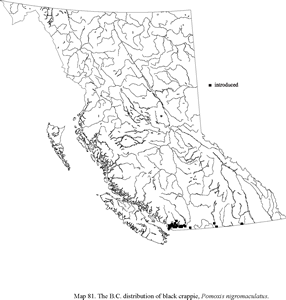This introduced species of fish is moderately sized (usually less than 300 mm in BC), has a deep, laterally compressed body, 36-40 scales along the lateral line, 7 or 8 well-developed spines in the dorsal fin. Colour of the dorsal, anal and caudal fins is irregular pale (yellow to light green) spots against a black background. For a detailed description and discussion of this species, refer to McPhail (2008).
Black Crappie
Family: Centrarchidae
Introduction
|
Species Information
Biology
|
Distribution
|
BC Distribution and Notes This is an eastern North American species. It is not a benign addition to our fish fauna: most small native fishes have disappeared in lakes containing black crappie (e.g., Whonnock Lake near Ruskin). It is not clear if these extirpations result from competitive interactions, predation, or both. What is clear is that this species should never be introduced into waters where they do not occur. Source: Information provided by Don McPhail for E-Fauna BC. Global Distribution North America: widely introduced throughout USA that native range is difficult to determine; presumably Atlantic Slope from Virginia to Florida, Gulf Slope west to Texas in the USA, St. Lawrence-Great Lakes and Mississippi River basins from Quebec to Manitoba in Canada south to Gulf of Mexico. Source: FishBase. Page, L.M. and B.M. Burr 1991 A field guide to freshwater fishes of North America north of Mexico. Houghton Mifflin Company, Boston. 432 p. |
Status Information
|
BC Ministry of Environment: BC Species and Ecosystems Explorer--the authoritative source for conservation information in British Columbia. |
